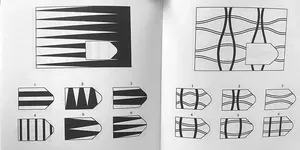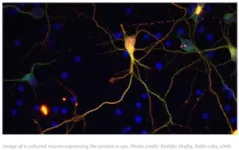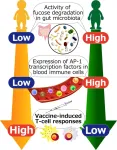(Press-News.org) Aggressive periodontitis is a severe type of gum infection that causes the destruction of ligament and bone and can lead to tooth loss in otherwise healthy individuals. Traditional treatment typically involves deep cleaning and antibiotics.
Lehigh University researcher Angela Brown and her team were recently awarded a grant from the National Institutes of Health (NIH) to pursue a novel treatment alternative.
Brown, an associate professor of chemical and biomolecular engineering in Lehigh’s P.C. Rossin College of Engineering and Applied Science, received an Exploratory/Development Research Grant Award (R21) to develop a nonsurgical drug delivery system that will enable the controlled delivery of antibiotics to treat aggressive periodontitis in adolescents. According to the NIH, R21 grants are meant to encourage research in high risk/high reward areas that could lead to significant breakthroughs or yield novel techniques, methods, and applications that will benefit biomedical, behavioral, or clinical research.
“The way these infections are typically treated is by scaling and planing, which essentially means scraping off the bacteria, and then prescribing oral antibiotics,” says Brown. “And while that tends to work, sometimes the bacteria come back, and then you have to start the course of antibiotics all over again. The more frequently you take antibiotics, the greater the chances the bacteria will become resistant to them.”
Antibiotic resistance is indeed a growing problem. According to the Centers for Disease Control and Prevention, more than 2.8 million antimicrobial-resistant infections occur every year in the U.S., and more than 35,000 people die as a result.
In previous work, Brown and her team have shown that antibiotics can be encapsulated in liposomes—tiny, round vesicles that contain one or more membranes and can be used as a delivery mechanism. They’ve also shown that the toxin released by the periodontitis-causing bacteria, called leukotoxin, triggers the release of the antibiotics.
“Leukotoxin fights the body’s immune response by binding with cholesterol in the membrane of white blood cells, disrupting the membrane and killing the cells,” she says. “So we’re creating a liposome that has cholesterol, and we’re hoping that all or most of the toxin will bind onto the liposome instead of the host cells,” says Brown. “When the toxin binds to the liposome, it should cause a release of the antibiotics, killing the disease-causing bacteria.”
This grant will support the cell culture work her lab will perform to determine if the approach can protect the host cells from the toxin while simultaneously killing the bacterial cells. They will do this using a "co-culture" model, in which human immune cells and bacterial cells are grown together.
The ultimate goal, she says, is to provide an alternative method of delivering antibiotics to treat aggressive periodontitis.
“We’d also like to continue showing the advantages of using controlled delivery strategies for antibiotics,” she says. “And because this toxin we’re working with is closely related to those that cause diseases like whooping cough and cholera and E. coli infections, this approach could be useful against a range of bacteria.”
Brown has been working with leukotoxins since she was a postdoctoral student. At that time, she was focusing on how the toxin interacted with the cell membrane. Her research team found that when they encapsulated fluorescent dye inside a cell, the toxin caused the release of the dye.
“Because I’m an engineer, I had this thought, Okay, now that we know the toxin has that effect, how can we use that?” she says. “It was just a vague idea back then, but I was thinking about how cool it would be if we could encapsulate antibiotics inside cells.”
Years later, the vague idea became real. One of her master’s students, Ziang Li—now a PhD student co-advised by both Brown and Professor Steve McIntosh, who chairs Lehigh’s chemical and biomolecular engineering department—wanted to research drug delivery mechanisms.
“At the time, it wasn’t something our lab was doing, but I said to him, ‘I have this crazy idea, do you want to try it?’”
With significant support from a Lehigh Faculty Innovation Grant, Li was able to collect the preliminary data that ultimately led to the NIH funding.
“Looking at different delivery strategies for antibiotics represents a new direction for my lab,” she says. “This is our first externally funded project to do this work, and it validates the idea that this approach has a lot of potential to solve problems with both disease and with antibiotic resistance.”
Research reported in this story is supported by the National Institute of Dental and Craniofacial Research of the National Institutes of Health under award number R21DE032153.
Related Links
Faculty Profile: Angela Brown
NIH RePORTER (R21DE032153): "Controlled antibiotic delivery vehicle for treatment of aggressive periodontitis" END
Novel antibiotic-delivery system to target aggressive gum infections in adolescents
With NIH support, Lehigh University chemical engineer Angela Brown is developing a liposome-based method to kill periodontitis-causing leukotoxin while protecting immune cells that fight infection
2023-04-20
ELSE PRESS RELEASES FROM THIS DATE:
Is Deep Learning a necessary ingredient for Artificial Intelligence?
2023-04-20
The earliest artificial neural network, the Perceptron, was introduced approximately 65 years ago and consisted of just one layer. However, to address solutions for more complex classification tasks, more advanced neural network architectures consisting of numerous feedforward (consecutive) layers were later introduced. This is the essential component of the current implementation of deep learning algorithms. It improves the performance of analytical and physical tasks without human intervention, and lies behind everyday automation products such as the emerging technologies for self-driving cars and autonomous chat bots.
The key question driving new research published today in Scientific ...
Study gives insight into cause of severe inflammatory bowel disease
2023-04-20
Cedars-Sinai investigators have identified a genetic variant that increases people’s risk of developing perianal Crohn’s disease, the most debilitating manifestation of Crohn’s disease.
The variant generates changes to DNA that lead to a loss of protein function, which in turn, alters how the body recognizes and handles bacteria, making it less effective at fighting infections.
The discovery is published in the peer-reviewed journal GUT.
“Fistulizing perianal Crohn’s disease ...
Gut bacteria could be behind weaker immune responses to COVID-19 vaccine
2023-04-20
Gut bacteria that break down a sugar called fucose could be dampening our immune response to the COVID-19 mRNA vaccine, according to a study led by researchers from the Okinawa Institute of Science and Technology (OIST).
The scientists report that increased fucose digestion by bacteria in the gut before vaccination was associated with lower numbers of T-cells activated by vaccination. T-cells are an important type of blood immune cell that are activated by a specific strain of bacteria or virus, and then multiply to fight the infection.
The findings, published ...
Swedish quantum computer applied to chemistry for the first time
2023-04-20
There are high expectations that quantum computers may deliver revolutionary new possibilities for simulating chemical processes. This could have a major impact on everything from the development of new pharmaceuticals to new materials. Researchers at Chalmers University have now, for the first time in Sweden, used a quantum computer to undertake calculations within a real-life case in chemistry.
“Quantum computers could in theory be used to handle cases where electrons and atomic nuclei move in more complicated ways. If we can learn to utilise their full potential, we should be able to advance the boundaries of what is possible to calculate and understand,” says Martin Rahm, ...
Polar ice sheet melting records have toppled during the past decade
2023-04-20
The seven worst years for polar ice sheets melting and losing ice have occurred during the past decade, according to new research, with 2019 being the worst year on record.
The melting ice sheets now account for a quarter of all sea level rise – a fivefold increase since the 1990’s – according to IMBIE, an international team of researchers who have combined 50 satellite surveys of Antarctica and Greenland taken between 1992 and 2020.
Their findings are published today in the journal Earth System Science Data.
Global heating is melting ...
Companies’ zero-deforestation commitments have potential to halve cattle-driven deforestation in Brazilian Amazon
2023-04-20
Cattle-rearing is the biggest cause of tropical deforestation in the Amazon - and the world.
A study has found that some of the world’s largest slaughterhouses reduced cattle-driven deforestation in the Amazon by 15% - equivalent to sparing 7,000km2 of forest from clearance (4.5 times the size of London) - through their commitment to zero-deforestation policies between 2010 and 2018.
If these policies were fully implemented and adopted across all cattle companies operating in the Amazon, 24,000km2 of forest (an area larger than Wales) could have been spared over this time, effectively halving cattle-driven deforestation in Brazil.
Deforestation ...
Exposure to air pollution during pregnancy increases risk for flu
2023-04-20
During pregnancy, women are more susceptible to severe respiratory infections from multiple viruses, including influenza A virus (IAV), respiratory syncytial virus (RSV) and severe acute respiratory syndrome coronavirus (SARS-CoV-2). Additionally, pregnant women are disproportionately affected by influenza, resulting in a more than 10-fold increase in hospitalization risk.
A new study led by Dr. Natalie Johnson, associate professor in the Texas A&M University School of Public Health’s Department of Environmental and Occupational Health, shows that exposure to ultrafine particles (UFPs) during pregnancy enhances respiratory ...
Trim the sugar: New HIV vaccine design improves immune response
2023-04-20
LA JOLLA, CA— A new HIV vaccine from Scripps Research has shown a significantly improved ability to neutralize the virus in preclinical tests, and it will soon be studied in healthy people who volunteer to participate in clinical trials.
The new and unique vaccine design, described in a paper in Nature Communications on April 9, 2023, uses tiny protein “nanoparticles” to display multiple copies of HIV’s surface protein Env, thus presenting itself to the immune system much as real HIV particles would ...
Immediate carbon cuts, common marine heatwave terminology urged
2023-04-20
Over the past two hundred years, the ocean and atmosphere have been accumulating massive amounts of carbon dioxide as factories, automobiles, airplanes, and more churn out the powerful greenhouse gas. Two articles published recently in Nature by University of Hawai‘i at Mānoa oceanographers provide a reality check on the limitations of carbon dioxide removal and a warning that marine heatwaves need clear definitions so communities can adapt.
Carbon dioxide removal is not the golden ticket
In all the scenarios assessed by the Intergovernmental Panel on Climate Change, nations around the world must dramatically and rapidly reduce their dependence ...
Paul Hessburg receives Distinguished Landscape Ecologist Award
2023-04-20
Paul Hessburg received the International Association for Landscape Ecology-North America Chapter’s 2023 Distinguished Landscape Ecologist Award. The annual award recognizes major scientific contributions to landscape ecology, honors scientists who have played a pivotal role in shaping the field, and is the organization’s highest honor.
Hessburg is a senior research ecologist with the USDA Forest Service's Pacific Northwest Research Station based at the Wenatchee Forestry Sciences Laboratory. He was honored for a highly diverse career that has "greatly enhanced the capacity of landscape practitioners to develop strategies and ...
LAST 30 PRESS RELEASES:
New expert guidance urges caution before surgery for patients with treatment-resistant constipation
Solar hydrogen can now be produced efficiently without the scarce metal platinum
Sleeping in on weekends may help boost teens’ mental health
Study: Teens use cellphones for an hour a day at school
After more than two years of war, Palestinian children are hungry, denied education and “like the living dead”
The untold story of life with Prader-Willi syndrome - according to the siblings who live it
How the parasite that ‘gave up sex’ found more hosts – and why its victory won’t last
When is it time to jump? The boiling frog problem of AI use in physics education
Twitter data reveals partisan divide in understanding why pollen season's getting worse
AI is quick but risky for updating old software
Revolutionizing biosecurity: new multi-omics framework to transform invasive species management
From ancient herb to modern medicine: new review unveils the multi-targeted healing potential of Borago officinalis
Building a global scientific community: Biological Diversity Journal announces dual recruitment of Editorial Board and Youth Editorial Board members
Microbes that break down antibiotics help protect ecosystems under drug pollution
Smart biochar that remembers pollutants offers a new way to clean water and recycle biomass
Rice genes matter more than domestication in shaping plant microbiomes
Ticking time bomb: Some farmers report as many as 70 tick encounters over a 6-month period
Turning garden and crop waste into plastics
Scientists discover ‘platypus galaxies’ in the early universe
Seeing thyroid cancer in a new light: when AI meets label-free imaging in the operating room
Neutrophil-to-lymphocyte ratio may aid risk stratification in depressive disorder
2026 Seismological Society of America Annual Meeting
AI-powered ECG analysis offers promising path for early detection of chronic obstructive pulmonary disease, says Mount Sinai researchers
GIMM uncovers flaws in lab-grown heart cells and paves the way for improved treatments
Cracking the evolutionary code of sleep
Medications could help the aging brain cope with surgery, memory impairment
Back pain linked to worse sleep years later in men over 65, according to study
CDC urges ‘shared decision-making’ on some childhood vaccines; many unclear about what that means
New research finds that an ‘equal treatment’ approach to economic opportunity advertising can backfire
Researchers create shape-shifting, self-navigating microparticles
[Press-News.org] Novel antibiotic-delivery system to target aggressive gum infections in adolescentsWith NIH support, Lehigh University chemical engineer Angela Brown is developing a liposome-based method to kill periodontitis-causing leukotoxin while protecting immune cells that fight infection








